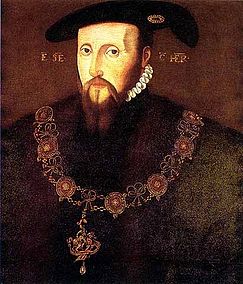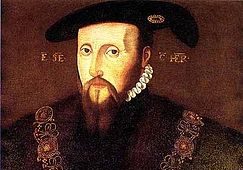
When Henry died on January 27, his will contemplated sixteen executors who would share power while his son was still a minor. Nice idea in principle, but even Henry found it impossible to impose his will after death. Somerset had been ready for this moment, and sprang into action.
The old King’s death was kept secret – according to the Spanish ambassador’s letters, “not even the slightest signs of such a thing were to be seen at Court, and even the usual ceremony of bearing in the royal dishes to the sound of trumpets was continued without interruption” – and all roads from London were closed until they had the new King with them and safely in the Tower. Meanwhile, Edward Seymour worked behind the scenes to seize power by get himself appointed Lord Protector – largely by figuring out the right bribes for the different Council members. And as long as rich offices were being handed out, why not one for the Lord Protector himself.
As W.K. Jordan puts it in his Edward VI: The Young King (quoting from Hargrave, Stow, and Edward VI himself),
The ceremony at the Tower, for all the haste in preparation, was elaborate and impressive. Before all the assembled nobility, Edward Seymour was first created a duke, being dressed in an ‘inner robe’ of honor, with the heralds preceding him, and the Garter next following. Then came the Earl of Shrewsbury carrying a verge (rod) of gold and Oxford carrying the duke’s cup and coronet of gold, while Arundel bore the sword. Escorted by the Duke of Suffolk and the Marquis of Dorset, Seymour offered his obedience to the child King sitting in the chair of state, and then knelt before him. Paget read the charter, while at the appropriate point Edward placed the duke’s mantle on Seymour, girt him with the sword, put the coronet on his head, gave him the verge of gold and pronounced him Duke of Somerset. Somerset then stood by the King while the others were ennobled.
(In case you were wondering, the Earl of Essex (William Parr) became the Marquis of Northampton, Viscount Lisle (John Dudley) became the Earl of Warwick, Lord Wriothesley became Earl of Southampton, Sir Thomas Seymour became Baron Seymour of Sudeley, Sir Richard Rich became Baron Rich of Leighs, Sir William Willoughby became Baron Willoughby of Parham, and Sir Edmund Sheffield became Baron Sheffield).
* * *
If you like my posts, you’ll love my books! My Seymour Saga trilogy tells the gripping story of the short-lived dynasty that shaped the Tudor Era. Jane the Quene skews romantic, The Path to Somerset is pure Game of Thrones (without the dragons), and The Boy King is a noir coming-of-age. Get them now through Amazon, Barnes & Noble, Kobo, and Apple, or even your local independent bookstore!

(PS Already read them? Did you love them? Then please review them – even just a stars rating! It makes a huge difference in helping new readers find them and would mean the world to me!)

Wow, by grabbing the duchy of Somerset, Edward Seymour made himself semi royal as this title was a Beaufort family title.